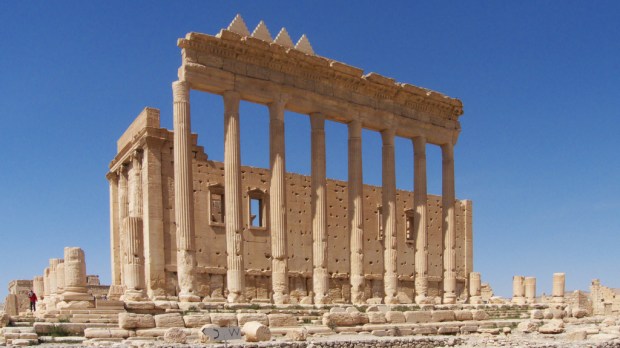Damascus, Aleteia (aleteia.org/ar) – The Islamic State of Iraq and the Levant posted a collection of pictures yesterday that portrays the destruction of a portion of a temple in Palmyra, which is a Greco-Roman archeological site that it had captured in March.
The jihadist group posted five pictures on the internet showing its fighters placing explosives within the Temple of Ba’al and on the surrounding walls. The other pictures depict powerful explosions and a pile of debris where the temple had once stood. The temple was once the most important building in Palmyra.
UNOSAT satellite analysis confirms Temple of #Bel#Palmyra#Syria main building destroyed @UNESCO @UrtheCast @UNITARpic.twitter.com/IZWRN0Tsil
— UNOSAT (@UNOSAT) August 31, 2015
UNESCO considers these actions perpetuated by ISIS as “war crimes.” According to UNESCO Director General Irina Bokova, these actions “have deprived the Syrian people of its knowledge, identity and history.”
ISIS, which took control over significant portions of Syria and Iraq last year, has this year already taken control of Palmyra, which is located in central Syria. They were able to take it from the hands of forces loyal to President al-Assad.
Fortunately, the government and officials from the site were able to transport most of the treasures, including hundreds of statues and placed them in a secure location before the city fell.
In the beginning, the jihadists had promised that they would not go close to the site; unfortunately, they did not hold true to that promise. Then, last month ISIS posted pictures depicting the destruction of some of the pieces that it had taken from Palmyra.
A week ago the retired archeologist, Khalid al-Assad was executed by beheading for refusing to assist ISIS in locating the hidden treasures.
In her interview with the Lebanese newspaper L’Orient-Le Jour, which is published in French, the archeologist Joanne Farchakh, who specializes in antiquities in times of war stated that, “the timing” of the temple’s destruction was “purely commercial.” ISIS cares only for the value of those archeological pieces and uses them as bargaining chips and extortion. In reality, these artifacts are a source of income in the same way that they use oil for income.
Mrs. Farchakh added, “When ISIS carried out a beheading in the Roman amphitheater, they were proving that they could do it in any other locations as well.” In reality, “Every act that ISIS commits is of value as propaganda in the beginning, and from there it serves as a piece in their military strategy.” This applies to the beheading of the archeologist Khalid al-Assad on Tuesday and the destruction of the temple.
Since taking control of approximately a third of Syria and Iraq last year, ISIS fighters have plundered the ancient Mosul library where they burned thousands of books. Likewise, they have also destroyed Shi’a mosques, Christian shrines and the ancient temple of Nimrud in Iraq.
The Director of UNESCO stated, “We have not seen anything like this since the Second World War.” We believe that we are facing “a most serious attack and the most barbarous and methodological destruction of the world’s heritage.”
Translated by Donald Puhlman.

